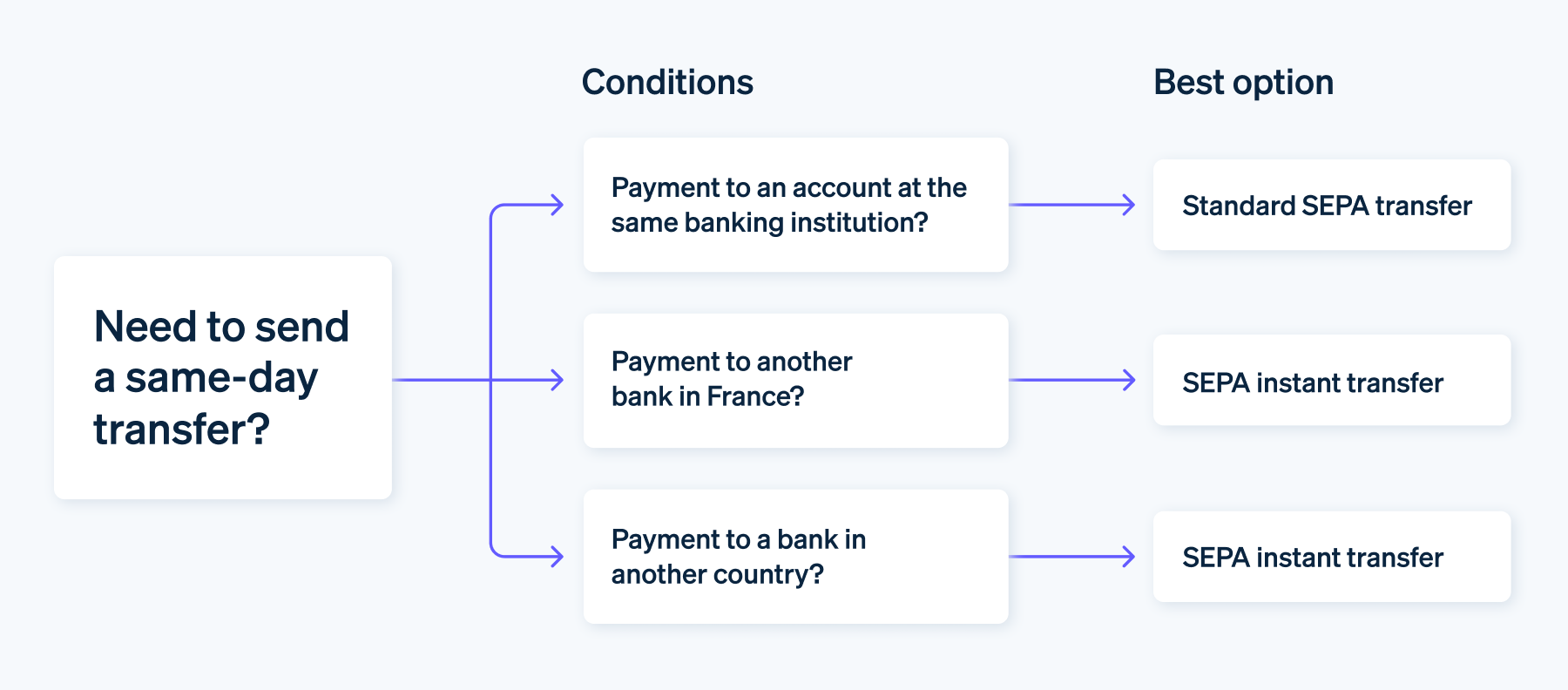O sistema SEPA (Área Única de Pagamentos em Euros) permite que empresas e clientes enviem e recebam facilmente pagamentos em euros na Europa. Para complementar o nosso guia que explica as transferências, este artigo examina especificamente as transferências SEPA e se concentra nos tempos de processamento para ajudar as empresas francesas a gerenciar melhor suas transações.
O que há neste artigo?
- Quanto tempo demora uma transferência SEPA?
- Quanto tempo demora um débito automático?
- Transferências instantâneas: rápidas, mas com tarifas
- Transferência SEPA não recebida: o que fazer
Quanto tempo demora uma transferência SEPA?
O tempo de processamento de uma transferência SEPA depende de vários fatores, como a data de início e o destino da transferência. Essas transações geralmente demoram até dois dias, mas a tabela abaixo detalha os principais tipos e os prazos esperados.
|
Tipo de transferência
|
Tempo de processamento
|
|---|---|
| Transferência dentro do mesmo banco | Imediata |
| Transferência para uma conta bancária externa | 1 a 3 dias úteis |
| Transferência para o Espaço Econômico Europeu | 4 dias úteis |
Tempo de processamento de transferências dentro do mesmo banco
Os tempos de processamento padrão para transferências SEPA podem ser incrivelmente rápidos quando elas ocorrem entre contas no mesmo banco francês, como o BNP Paribas. Sob certas condições, os fundos podem ser creditados na conta do destinatário quase imediatamente.
As transferências iniciadas antes das 18h nos dias de semana são geralmente processadas no mesmo dia. Depois das 18h ou nos fins de semana, elas são processadas no dia útil seguinte.
Tempos de processamento de transferências de SEPA externas
Os prazos de processamento das transferências de crédito SEPA entre bancos diferentes, dentro da França ou entre a França e outro país SEPA, são padronizados e geralmente variam de um a três dias úteis.
Por exemplo, uma transferência iniciada por um cliente do BNP Paribas para uma conta aberta no Société Générale na França ou um banco na Alemanha segue os mesmos procedimentos.
Tempos de processamento de transferências internacionais
Transferências dentro da zona SEPA, mas fora da área do euro – para contas no Espaço Econômico Europeu mais amplo, como Islândia, Liechtenstein, Mônaco, Noruega, San Marino e Suíça – geralmente demoram mais para serem processadas. Embora estas operações possam demorar até quatro dias úteis a chegar à conta do beneficiário, continuam a ser notavelmente mais rápidas do que as transferências internacionais tradicionais.
Quanto tempo demora um débito automático?
Os horários aqui se aplicam a transferências de crédito únicas (Transferência de crédito SEPA ou SCT). Para débitos automáticos SEPA, configurar o pagamento usando o mandato SEPA demora dois a três dias adicionais.
Uma vez estabelecido o mandato, as transações padrão entre contas do mesmo banco francês são instantâneas. Para contas externas e internacionais, a transferência ocorre na data especificada no mandato.
Transferências instantâneas: rápidas, mas com tarifas
Para atender à crescente necessidade de transações financeiras rápidas e minimizar os tempos de transferência, o Banco Central Europeu lançou a Transferência instantânea de crédito SEPA em 2017.
Esse serviço de pagamento, cada vez mais adotado pelos bancos, permite que fundos de até € 100.000 sejam transferidos quase que instantaneamente, normalmente em menos de 10 segundos. Também está disponível 24 horas por dia, todos os dias do ano.
Essa disponibilidade garante que o beneficiário receba os fundos imediatamente, com o mínimo de atraso na transferência. No entanto, muitas vezes elas apresentam uma taxa adicional, normalmente em torno de um euro, além das taxas bancárias usuais.

O gerenciamento de transferências SEPA é simplificado com as interfaces pré-configuradas do Stripe Payments. Com mais de 100 formas de pagamento disponíveis, as empresas podem gerenciar transações com eficiência, considerando os tempos de processamento.
Transferência SEPA não recebida: o que fazer
Uma transferência SEPA pode ser recusada por vários motivos. Os erros mais comuns são causados pelos dados bancários do beneficiário. Um erro de digitação do IBAN, BIC ou nome do titular da conta pode bloquear a transação.
Suponha que o limite de transferência expire e os fundos não tenham chegado à conta do beneficiário dentro de três dias úteis. Nesse caso, é melhor entrar em contato com seu banco e o banco emissor para determinar o problema e encontrar uma solução.
Ao contestar uma transação, qualquer empresa pode notificar o banco sobre a recusa ou fraude de uma transferência.
O conteúdo deste artigo é apenas para fins gerais de informação e educação e não deve ser interpretado como aconselhamento jurídico ou tributário. A Stripe não garante a exatidão, integridade, adequação ou atualidade das informações contidas no artigo. Você deve procurar a ajuda de um advogado competente ou contador licenciado para atuar em sua jurisdição para aconselhamento sobre sua situação particular.